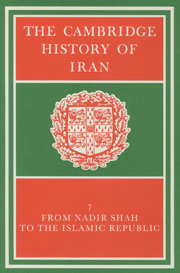Book contents
- Frontmatter
- PART 1 THE POLITICAL FRAMEWORK, 1722–1979
- 1 NĀDIR SHĀH AND THE AFSHARID LEGACY
- 2 THE ZAND DYNASTY
- 3 ĀGHĀ MUHAMMAD KHĀN AND THE ESTABLISHMENT OF THE QĀJĀR DYNASTY
- 4 IRAN DURING THE REIGNS OF FATH ‘Alī SHāH AND MUHAMMAD SHāH
- 5 IRAN UNDER THE LATER QĀJĀRS, 1848–1922
- 6 THE PAHLAVĪ AUTOCRACY: RIŻĀ SHĀH, 1921–41
- 7 THE PAHLAVĪ AUTOCRACY: MUHAMMAD RIŻĀ SHĀH, 1941–1979
- PART 2 FOREIGN RELATIONS
- PART 3 ECONOMIC AND SOCIAL DEVELOPMENTS
- PART 4 RELIGIOUS AND CULTURAL LIFE, 1721–1979
- Genealogical tables
- Bibliographies
- Index
- References
2 - THE ZAND DYNASTY
from PART 1 - THE POLITICAL FRAMEWORK, 1722–1979
Published online by Cambridge University Press: 28 March 2008
- Frontmatter
- PART 1 THE POLITICAL FRAMEWORK, 1722–1979
- 1 NĀDIR SHĀH AND THE AFSHARID LEGACY
- 2 THE ZAND DYNASTY
- 3 ĀGHĀ MUHAMMAD KHĀN AND THE ESTABLISHMENT OF THE QĀJĀR DYNASTY
- 4 IRAN DURING THE REIGNS OF FATH ‘Alī SHāH AND MUHAMMAD SHāH
- 5 IRAN UNDER THE LATER QĀJĀRS, 1848–1922
- 6 THE PAHLAVĪ AUTOCRACY: RIŻĀ SHĀH, 1921–41
- 7 THE PAHLAVĪ AUTOCRACY: MUHAMMAD RIŻĀ SHĀH, 1941–1979
- PART 2 FOREIGN RELATIONS
- PART 3 ECONOMIC AND SOCIAL DEVELOPMENTS
- PART 4 RELIGIOUS AND CULTURAL LIFE, 1721–1979
- Genealogical tables
- Bibliographies
- Index
- References
Summary
THE POWER STRUGGLE IN POST-NĀDIR IRAN
Scarcely any of the great conquerors of history can have destroyed his life's work quite so completely as Nādir Shāh did in the months before his death. His unreasonable exactions and barbarous suppression of the ensuing provincial revolts spread disaffection to every corner of his realms, and finally brought his own nephew, ‘Alī Qulī Khān, at the head of a rebel army, to the borders of Khurāsān itself. His short-sighted favouritism towards his new Afghan and Uzbek contingents, over his long-suffering Iranian officers and men, split his own army irreparably and was the immediate cause of his assassination.
The morning after this event (11 Jumādā II 1160/1 July 1747 New Style), his heterogeneous army, encamped at Khabūshān, rapidly disintegrated. The detested Afghans fought their way clear under Ahmad Khan Abdālī, who, as Ahmad Shāh Durrānī, later seized the eastern half of Nādir's domains; their compatriots in the Mashhad garrison were prudently allowed to retire by the governor and Superintendent (mutavallī) of the shrine, Mīr Sayyid Muhammad, who from now on was to play an important rôle in the troubled politics of the former capital. The bulk of the Iranian contingents, notably the Bakhtiyārī under ‘Alī Mardān Khān, struggled back to Mashhad, and initially gave their support to ‘Alī Qulī Khān who, with many promises and much largesse, was enthroned as ‘Adil Shāh a few weeks later.
But the new ruler soon disappointed many of his early adherents; he lacked his uncle's imperious magnetism to pull together the surviving elements of a sprawling and exhausted empire.
- Type
- Chapter
- Information
- The Cambridge History of Iran , pp. 63 - 103Publisher: Cambridge University PressPrint publication year: 1991
References
- 3
- Cited by



